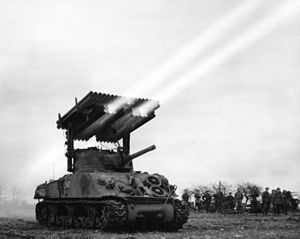M8 (rocket)
| M8 | |
|---|---|
 M8 rockets being launched from a "Calliope" multiple launcher mounted on a Sherman tank. | |
| Type | Air-to-surface and surface-to-surface rocket |
| Place of origin | United States |
| Service history | |
| Used by | United States Army, United States Navy |
| Production history | |
| Designer | Picatinny Arsenal |
| Designed | 1941 |
| Produced | 1941-1944 |
| Number built | 2,537,000[1] |
| Specifications | |
| Weight | 38 lb (17 kg) |
| Length | 33 in (840 mm) |
| Diameter | 4.5 in (110 mm) |
| Warhead | None |
| Warhead weight | 4.3 lb (2.0 kg) |
|
| |
| Engine |
Solid-fuel rocket 4.75 lb (2.15 kg) fuel |
Operational range | 4,600 yd (4.2 km) |
| Speed | 600 mph (970 km/h) |
Guidance system | None |
The M8 was a 4.5-inch (110 mm) rocket developed and used by the United States military during World War II. Produced in the millions, it was fired from both air- and ground-based launchers; it was replaced by the M16 rocket in 1945.
Development
The M8 rocket was developed by the National Defense Research Committee and the Army Ordnance Department in the early 1940s;[2] at Picatinny Arsenal.[3] Ground tests began in 1941, while the first air launch of the system was conducted in 1942, from a Curtiss P-40 pursuit aircraft.[2] It was fin stabilized, and had a diameter of 4.5 in (110 mm).[4]
The initial production model was given the Army designation of M8; improvements resulted in the M8A3, with a more powerful rocket engine and enlarged fins,[1] and the T22, which had improved reliability and modifications to make the rocket safer.[2]
Operational history
Entering service in 1943, the M8 family of rockets saw service with the United States Army, which classified the M8 as a "barrage rocket".[2] The rocket was also widely used by the United States Army Air Forces.[2] Over 2,500,000 of the M8 type rocket had been produced by the end of the war.[1]
Operational service showed some drawbacks in the M8's performance; ground launch resulted in the rockets' fin stabilizers proving ineffective,[4] reducing the accuracy of the rocket; despite this, it was considered an effective barrage weapon.[5] Due to the lack of accuracy, when ground-launched, it was being launched from large multiple launchers; the most commonly used being eight- and 60-tube launchers, called "xylophones" and "calliopes" respectively.[1][2] The "calliope", given the official designation T34, was mounted on top of a M4 Sherman tank; once fired, the launcher could be detached and discarded, allowing the tank to be used in conventional combat, while the "xylophone", officially the T27, was carried on a 2½-ton truck's cargo bed.[1] A 120-round launcher, designated T44, and a 144-round T45 launcher were also developed; these were intended for use by the United States Navy, being mounted on DUKW amphibious vehicles and LST amphibious warfare vessels. Single- and twin-14-round launchers were also developed.[1]
The M8 showed poor effectiveness against hardened targets;[2] this resulted in the development of the Super M8, which had larger fins, a more powerful rocket and a more powerful warhead. The Super M8 underwent testing in late 1944, but failed to see combat.[2] The M8 was replaced by the improved spin-stabilized M16 rocket during 1945.[1][4]
See also
- Rocket artillery
- RP-3 - British air-launched rocket
- Land Mattress, British ground-launched rocket battery based on RP-3
References
- ↑ 1.0 1.1 1.2 1.3 1.4 1.5 1.6 Chris Bishop, ed. (1998). The Encyclopedia of Weapons of World War II. New York: Orbis. p. 175. ISBN 1-58663-762-2.
- ↑ 2.0 2.1 2.2 2.3 2.4 2.5 2.6 2.7 Parsch, Andreas (2006). "Air-Launched 4.5-Inch Rockets". Directory of U.S. Military Rockets and Missiles, Appendix 4: Undesignated Vehicles. Designation-Systems. Retrieved 2012-01-19.
- ↑ Lassman, Thomas C. (2008). Sources of Weapon Systems Innovation in the Department of Defense: The Role of In-House Research and Development, 1945-2000. United States Army Center of Military History. p. 22. ISBN 978-1-4609-5845-2. Center of Military History Publication 51-2-1.
- ↑ 4.0 4.1 4.2 Parsch, Andreas (2006). "U.S. Army 4.5-Inch Barrage & Bombardment Rockets". Directory of U.S. Military Rockets and Missiles, Appendix 4: Undesignated Vehicles. Designation-Systems. Retrieved 2012-01-19.
- ↑ van Riper, A. Boudoin (2004). Rockets and Missiles: The Life Story of a Technology. Baltimore, Maryland: Johns Hopkins University Press. p. 44. ISBN 978-0-8018-8792-5.
External links
- 4.5 inch rocket in Smithsonian collection
- War Department Technical Manual 9-395 4.5" Aircraft Rocket Matériel
- War Department Technical Manual 9-394 4.5" Ground Rocket Matériel
| ||||||||
| ||||||||||||||